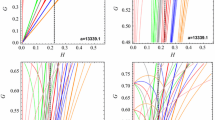Abstract
The short period luni-solar theory of Kozai is generalized for arbitrary obliquity of the ecliptic and inclination of the moon's orbit to the ecliptic. Analytic first order lunar perturbations to the elements are derived. The theory is illustrated by an application to the communication satellite Intelsat 3F3.
Similar content being viewed by others
References
Brouwer and Clemence: 1961, Methods of Celestial Mechanics, Academic Press.
Cayley, A.: 1861,Mem. Roy. Astron. Soc. 29, 191–306.
Explanatory Supplement to the Astronomical Ephemeris and the American Ephemeris and Nautical Almanac, Her Majesty's Stationery Office, London (1961).
Fisher, D.: 1971, ‘Lunisolar Perturbations of the Motion of Artificial Satellites’, Goddard Space Flight Center, X-552-71-60.
Kozai, Y.: 1959, ‘On the Effects of the Sun and the Moon Upon the Motions of a Close Earth Satellite’, SAO Special Report 22, Smithsonian Institution Astrophysical Observatory.
Kozai, Y.: 1966, ‘Lunisolar Perturbations with Short Periods’, SAO Special Report 235, Smithsonian Institution Astrophysical Observatory.
Author information
Authors and Affiliations
Rights and permissions
About this article
Cite this article
Fisher, D. Analytic short period lunar and solar perturbations of artificial satellites. Celestial Mechanics 6, 447–467 (1972). https://doi.org/10.1007/BF01227758
Received:
Issue Date:
DOI: https://doi.org/10.1007/BF01227758




